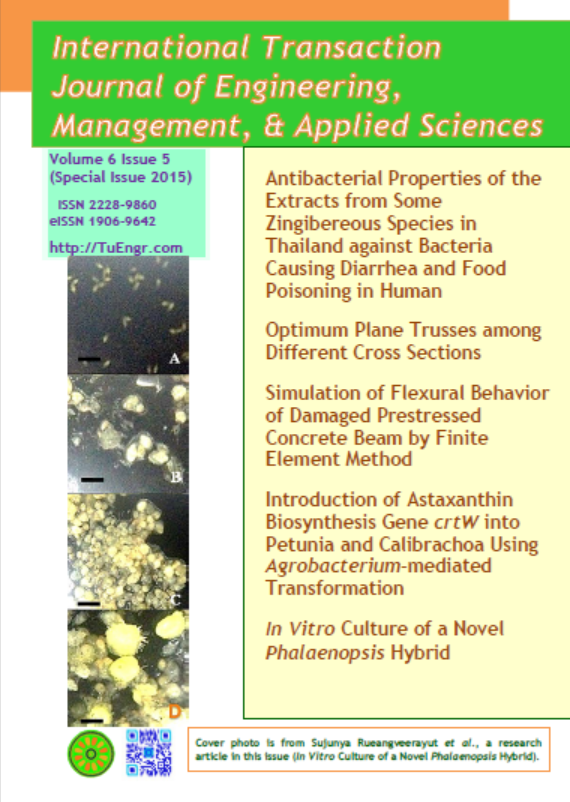- Antibacterial Properties of the Extracts from Some
Zingibereous Species in Thailand against Bacteria
Causing Diarrhea and Food
Poisoning in Human
 Kullanitpitch Udomthanadech (Department of Horticulture, Faculty of Agriculture, Kasetsart University, THAILAND ), Srunya Vajrodaya* (Department of Botany, Faculty of Science, Kasetsart University, Bangkok, THAILAND), and Yingyong Paisooksantivatana (Department of Horticulture, Faculty of Agriculture, Kasetsart University, THAILAND )
Kullanitpitch Udomthanadech (Department of Horticulture, Faculty of Agriculture, Kasetsart University, THAILAND ), Srunya Vajrodaya* (Department of Botany, Faculty of Science, Kasetsart University, Bangkok, THAILAND), and Yingyong Paisooksantivatana (Department of Horticulture, Faculty of Agriculture, Kasetsart University, THAILAND )
(Quality file)
doi: 10.14456/itjemast.2015.4
Keywords:
zingiberaceous plant extracts;
Zingiberaceae; Ethanolic extract;
Aerobic;
Anaerobic.
Abstract
Many of Zingiberaceous plants play important roles in Thai society more than hundred years ago. For example, they are used as herbal medicines for disorders related to digestive tract. Even though the pharmacology and chemical compositions of these plants were reported, but there are only a few reports on antibacterial activities. This study intend to screen for antibacterial property of the ethanolic extracts from some Zingiberaceae species i.e. Zingiber montanum, Z. ottensii, Z. officinale, Z. zerumbet, Zingiber ‘Phlai Chomphu’, Alpinia galanga, Boesenbergia rotunda, and Kaempferia parviflora. The ethanolic extracts were tested with bacteria which are the common causes of diarrhea and food poisoning in humans, Salmonella typhimurium, Escherichia coli, Staphylococcus aureus, Enterococcus faecalis, Listeria monocytogenes, and Mycobacterium smegmatis. The test, OD was measured under both aerobic and anaerobic conditions. It found that under aerobic condition the extracts of Z. officinale and Zingiber ‘Phlai Chomphu’ showed the effect against L. monocytogenes while the extracts from Zingiber ‘Phlai Chomphu’, B. rotunda and K. parviflora showed the effect against M. smegmatis. For anaerobic condition, the extracts of Z. officinale, Zingiber ‘Phlai Chomphu’ and A. galanga showed the effect against S. typhimurium whereas the extracts of K. parviflora showed the effect against S. aureus. The extracts of Z. montanum, Z. ottensii and Z. zerumbet showed no antibacterial property while those of Zingiber ‘Phlai Chomphu’ and A. galanga showed the strongest antimicrobial property.
- Optimum Plane Trusses among Different Cross Sections
 Sumayah Abdulsalam Mustafa * ,
(School of Environmental Engineering, Universiti Malaysia Perlis, MALAYSIA ), Mohd Zulham Affandi Bin Mohd Zahid (Department of Civil Engineering Technology, Faculty of Engineering Technology, Universiti Malaysia Perlis, MALAYSIA), and Hafedh Abed Yahya (Department of Architectural Engineering, University of Mosul, IRAQ )
Sumayah Abdulsalam Mustafa * ,
(School of Environmental Engineering, Universiti Malaysia Perlis, MALAYSIA ), Mohd Zulham Affandi Bin Mohd Zahid (Department of Civil Engineering Technology, Faculty of Engineering Technology, Universiti Malaysia Perlis, MALAYSIA), and Hafedh Abed Yahya (Department of Architectural Engineering, University of Mosul, IRAQ )
(Quality file)
doi: 10.14456/itjemast.2015.2
Keywords:
Cross-Section;
Optimum Weight;
STAAD;
Fink fan; Fan; Fink; Howe; Pratt; Mansard.
Abstract
This work aims to find the optimum cross section shape that offers optimum plane trusses. The expression optimal structure is extremely vague because of the structure may be optimal in different aspects. These aspects are known as objectives. Weight optimization of structures plays a major role due to its significant effect to overall costs. The research uses finite element method by the aid of STAAD software for analysis and sizing optimization design for six trusses types which are common used for span12m. Different cross sections shapes are used to verify the one that gives optimal truss weight. Many of previous existing researches employ the areas of cross sections as design variables without heightening to the shape of cross section at the beginning of the process: accordingly the result area may be not sufficient in case that the designer do not select the effective shape than others. Results of this paper show that the chosen cross section shape has a significant impact on the weight trusses optimization which is formulated selecting a set of design variables that represent the structural and architectural configuration of the system.
- Simulation of Flexural Behavior of Damaged Prestressed Concrete Beam by Finite Element Method
 Paradorn Matchan, Sayan Sirimontree*, and Boonsap Witchayagkoon
(Department of Civil Engineering Faculty of Engineering, Thammasat University, THAILAND )
Paradorn Matchan, Sayan Sirimontree*, and Boonsap Witchayagkoon
(Department of Civil Engineering Faculty of Engineering, Thammasat University, THAILAND )
(Quality file)
doi: 10.14456/itjemast.2015.3
Keywords:
Structural degradation;
Post- tension;
T-beam;
Flexural stiffness;
Permanent deformation.
Abstract
Finite element model is applied to simulate the flexural behavior of bonded post tension prestressed concrete (PC) T beam. Flexural behavior of PC beam is characterized by load-deformation relationship in both linear elastic uncrack and nonlinear after cracking stage. Analytical software, ANSYS, is utilized the simulation of flexural behaviors both loading and unloading path. Nonlinearity of materials are considered and taken into account. The developed model is verified by experimental results. The study finds good agreement between analytical and experimental results. Degradation of PC girder due to overload beyond cracking can be expressed by the loss of flexural stiffness and permanent deformation after unloading due to accumulated cracks. The verified finite element model can be parametrically used to predict flexural behavior of PC beam in various levels of overloading.
- Introduction of Astaxanthin Biosynthesis Gene crtW into Petunia and Calibrachoa Using Agrobacterium-mediated Transformation
 Bodin Phadungsawat, Thunya Taychasinpitak, Shermarl Wongchaochant,
(Department of Horticulture, Faculty of Agriculture, Kasetsart University, Bangkok, THAILAND )
and Sakae Suzuki*
(Horticultural Science Laboratory, Department of Biological Production, Faculty of Agriculture, Tokyo University of Agriculture and Technology, Fuchu, Tokyo, JAPAN )
Bodin Phadungsawat, Thunya Taychasinpitak, Shermarl Wongchaochant,
(Department of Horticulture, Faculty of Agriculture, Kasetsart University, Bangkok, THAILAND )
and Sakae Suzuki*
(Horticultural Science Laboratory, Department of Biological Production, Faculty of Agriculture, Tokyo University of Agriculture and Technology, Fuchu, Tokyo, JAPAN )
(Quality file)
doi: 10.14456/itjemast.2015.1
Keywords:
Carotenoid;
Genetic engineering;
Brevundimonas sp.;
EHA105.
Abstract
Agrobacterium-mediated gene transfer method for transferring crtW gene was investigated in Petunia and Calibrachoa by using Agrobacterium tumefaciens strain EHA105, harboring a plasmid containing the crtW gene from Brevundimonas sp. strain SD212 under 35S promoter with kanamycin resistant gene for selection. Co-cultivation was done using leaf disk method for 3 days in Agrobacterium solution with 20 ppm acetosyringone and selection was carried out on selective MS medium containing 200 ppm kanamycin. Inoculated leaf explants of Petunia and Calibrachoa produced putative transgenic callus tissue that demonstrated orange color and astaxanthin accumulation. The result of PCR analysis indicated the Petunia and Calibrachoa calluses contained the crtW gene and RT-PCR result showed crtW gene expression in the callus tissue.
- In Vitro Culture of a Novel Phalaenopsis Hybrid
 Sujunya Rueangveerayut, Kisana Bhinija, and Panu Ruangjan *
(Plant Tissue Culture Unit, Lab of Biotechnology, Chulabhorn Research Institute THAILAND )
Sujunya Rueangveerayut, Kisana Bhinija, and Panu Ruangjan *
(Plant Tissue Culture Unit, Lab of Biotechnology, Chulabhorn Research Institute THAILAND )
(Quality file)
doi:
Keywords:
In Vitro cultured;
Protocorm like bodies; Multiplication;
Kinetin.
Abstract
This research aims to create novel Phalaenopsis hybrids from Phalaenopsis species in the small flowers group (Subgenus Phalaenopsis, Section Esmeralda). Forty-four lines in the 2nd segregated lines of novel Phalaenopsis hybrids developed from self and sib hybridization from 1st segregated lines were selected for investigation due to their high potential for commercial development. Tissue culture experiments were undertaken to study multiplication of the 2nd segregated lines. The seed pods were sterilized in vitro and tested for seed germination. A protocol of plantlets multiplication was developed and focused on finding the most suitable plant growth regulators and their concentrations. The results showed that an effective method for surface sterilizing seed pods was to use Clorox® 10 % for 5 or 10 minutes. The best seed germination medium was MS medium supplemented with 15 % young coconut water and 3 % sucrose. Superior shoot induction was medium with kinetin (Kin) 3 µM after 8 weeks of growth. The highest root formation was 65 %, and 35% of plants grew 3 roots on average in medium with 1-naphthylacetic acid (NAA) 3 µM. The process from seeds to plantlets used for transplanting to the field test was done within 18 months.

 Read full issue
Read full issue

 Kullanitpitch Udomthanadech (Department of Horticulture, Faculty of Agriculture, Kasetsart University, THAILAND ), Srunya Vajrodaya* (Department of Botany, Faculty of Science, Kasetsart University, Bangkok, THAILAND), and Yingyong Paisooksantivatana (Department of Horticulture, Faculty of Agriculture, Kasetsart University, THAILAND )
Kullanitpitch Udomthanadech (Department of Horticulture, Faculty of Agriculture, Kasetsart University, THAILAND ), Srunya Vajrodaya* (Department of Botany, Faculty of Science, Kasetsart University, Bangkok, THAILAND), and Yingyong Paisooksantivatana (Department of Horticulture, Faculty of Agriculture, Kasetsart University, THAILAND )
 Sumayah Abdulsalam Mustafa * ,
(School of Environmental Engineering, Universiti Malaysia Perlis, MALAYSIA ), Mohd Zulham Affandi Bin Mohd Zahid (Department of Civil Engineering Technology, Faculty of Engineering Technology, Universiti Malaysia Perlis, MALAYSIA), and Hafedh Abed Yahya (Department of Architectural Engineering, University of Mosul, IRAQ )
Sumayah Abdulsalam Mustafa * ,
(School of Environmental Engineering, Universiti Malaysia Perlis, MALAYSIA ), Mohd Zulham Affandi Bin Mohd Zahid (Department of Civil Engineering Technology, Faculty of Engineering Technology, Universiti Malaysia Perlis, MALAYSIA), and Hafedh Abed Yahya (Department of Architectural Engineering, University of Mosul, IRAQ )
 Paradorn Matchan, Sayan Sirimontree*, and Boonsap Witchayagkoon
(Department of Civil Engineering Faculty of Engineering, Thammasat University, THAILAND )
Paradorn Matchan, Sayan Sirimontree*, and Boonsap Witchayagkoon
(Department of Civil Engineering Faculty of Engineering, Thammasat University, THAILAND )
 Bodin Phadungsawat, Thunya Taychasinpitak, Shermarl Wongchaochant,
(Department of Horticulture, Faculty of Agriculture, Kasetsart University, Bangkok, THAILAND )
and Sakae Suzuki*
(Horticultural Science Laboratory, Department of Biological Production, Faculty of Agriculture, Tokyo University of Agriculture and Technology, Fuchu, Tokyo, JAPAN )
Bodin Phadungsawat, Thunya Taychasinpitak, Shermarl Wongchaochant,
(Department of Horticulture, Faculty of Agriculture, Kasetsart University, Bangkok, THAILAND )
and Sakae Suzuki*
(Horticultural Science Laboratory, Department of Biological Production, Faculty of Agriculture, Tokyo University of Agriculture and Technology, Fuchu, Tokyo, JAPAN )
 Sujunya Rueangveerayut, Kisana Bhinija, and Panu Ruangjan *
(Plant Tissue Culture Unit, Lab of Biotechnology, Chulabhorn Research Institute THAILAND )
Sujunya Rueangveerayut, Kisana Bhinija, and Panu Ruangjan *
(Plant Tissue Culture Unit, Lab of Biotechnology, Chulabhorn Research Institute THAILAND )